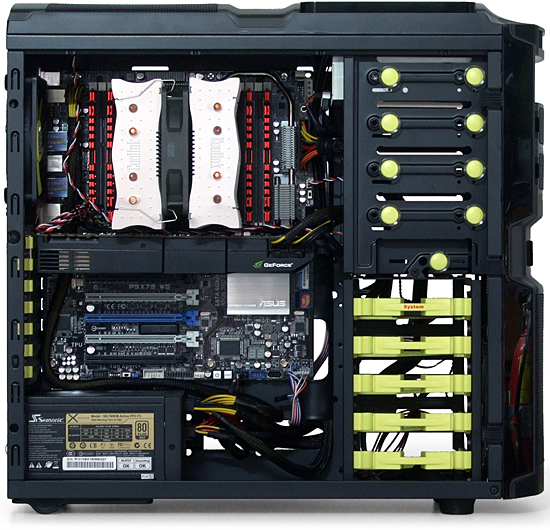The Final Five: Gaming Cases Between $80 And $120, Rounded-Up
Our 15-way shootout of cases priced between $80 and $120 ends as we compare the last five models to the previous ten, yielding an overall winner. Which chassis offers the best balance of quality, cooling, and noise reduction, and which is the best buy?
Building With The In Win Buc
Larger, sturdier, heavier, and with more drive bays than the previously-tested Mana 136, In Win’s Buc might just alleviate our doubts about the quality of In Win's Style brand.
Even with the higher-grade Buc, In Win continues to support the legacy AC'97 audio standard. This leaves an ugly cable end flopping around inside an otherwise tidy system.
The Buc's installation kit matches a few competitors by sorting its screws into separate packs. In Win also adds a four-pin drive power connector to three-pin fan power adapter, though we certainly hope that anyone using this case has enough three-pin connectors on their motherboard.
The Buc also features screwless card clips, a feature formerly associated with high-end cases. Conversely, the company goes cheap by using break-out-style slot covers instead of replaceable slot covers in six of the enclosure's seven slots.
The Buc’s drive tray uses noise-dampening grommets for 3.5” drives, but mounts 2.5” drives directly to the base. Offsetting the smaller drives to one side assures proper SATA connector alignment within the four-drive backplane.


Pins on 5.25” external bays slide out to allow drive insertion, and slide back in to secure the drive.
The Buc lacks a proper access hole for passing our eight-pin EPS12V connector through the motherboard tray to the top of our board. A nearby access hole is simply too low for the connector to fit through. Also slightly inconvenient is a cable routing space that limits larger cords to a channel along the front part of the motherboard tray.
Get Tom's Hardware's best news and in-depth reviews, straight to your inbox.
Cable-routing patience pays off in a dramatic (and practical) completed build.
Current page: Building With The In Win Buc
Prev Page Building With The Corsair 400R Next Page Building With The MSI Ravager-
dudewitbow idroidToms should do a review on high-end cases featuring EXTREME watercooling.Reply
the only tiny problem at the most part i see in that is that it would be slightly harder to test thermal efficiency, since its being cooled by water, rather than air + hsf so in a wc build, the thermal ratings will be extremely close. -
back_by_demand It would be nice to see a left-sided window case listing, there are definate advantages to a left sided window / upside down mobo configReply -
Crashman amuffinThe Antec Solo II is not a case meant for gaming.Well...Antec sent it anyway. Along with the Eleven Hundred. So they evidently had a plan.back_by_demandIt would be nice to see a left-sided window case listing, there are definate advantages to a left sided window / upside down mobo configDid you know that the reason many manufacturers abandoned the upside-down case was because some motherboard heat pipes supposedly didn't work right in that configuration?iknowhowtofixitBut, but, but.... The Phantom 410 is sooooo ugly...Eye of the beholder :)Reply
-
The Solo II would probably have done a little better with your LGA2011 / GTX580 setup, if Antec included at least one front intake fan. Any chance of a re-test with an added intake fan or two? :)Reply
-
antemon I'm a fan of smaller casesReply
I have a qx-2000 case from aerocool. it's a nightmare for cable management and upgrading partsm but I like it
can toms also do an in-depth article on smaller cases?
particularly, I want a similar case as the qx-2000 but the PSU is mounted at the bottom so that adding items inside woundnt be too much of a chore.
thermaltake armor a30 looks awesome, but still has a top mounted PSU






